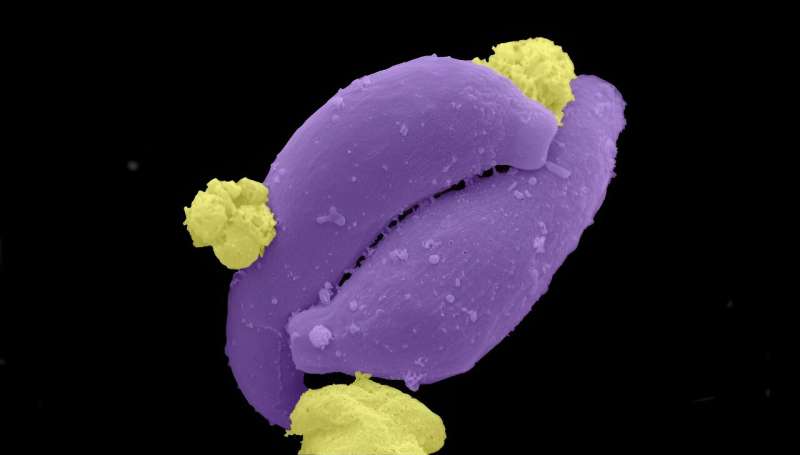This article has been reviewed according to Science X's editorial process and policies. Editors have highlighted the following attributes while ensuring the content's credibility:
fact-checked
peer-reviewed publication
proofread
Ultrasensitive tools detect asymptomatic malaria

Researchers in the U.S. and Uganda have developed tools that can detect the slightest traces of malaria in people who harbor the disease but do not show signs of sickness.
Malaria is the leading cause of illness and death in many low-income countries, with young children and pregnant women most affected.
In 2022, there were 608,000 malaria deaths worldwide, with 95% of them occurring in the African region, according to the World Health Organization.
Detecting malaria in people who do not show symptoms is vital in order to better control the tropical disease in endemic areas, the researchers said in a study published this month (4 January) in the journal The Lancet Microbe.
The scientists from the University of Washington and Med Biotech Laboratories in Kampala said that due to the changing nature of malaria pathogens, parasite densities in the blood can suddenly drop below the level of detection. This is especially the case when older, less sensitive tests are used and when testing is done only at a single point in time.
Sean Murphy, professor of laboratory medicine and pathology at the University of Washington and lead author of the study, said, "To make anti-infection vaccines, drugs and therapeutics and test them in endemic areas means that you need diagnostic tools that can detect even the lowest density infections."
He noted that the ultrasensitive molecular diagnostic tools are more analytically sensitive than other tests like blood smear, malaria rapid diagnostics tests, and even other types of molecular tests.
"This means we can 'see deeper into the water' and identify true, albeit low density infections that would have been missed by other tests," Murphy said.
Murphy explains that having all this information can help researchers better assess candidate vaccines and drugs to decide which products provide the most effective outcomes.
Ultrasensitive tests
The researchers used ultrasensitive molecular diagnostic tools to test adults aged 18 to 59 and children aged 8 to 17 who were not pregnant and were not under malaria medication in the Katawki district in eastern Uganda, which has a high incidence of malaria.
They tested dried blood spots for the presence of Plasmodium ribosomal RNA, which helps produce the parasite proteins, to determine and classify the type and densities of the parasites over a period of one month.
By analyzing the resulting data, the researchers hoped to discern a sampling schedule—comparable to testing every day but less burdensome—to reliably identify asymptomatic cases.
About 60% of participants had a Plasmodium infection at some point during the study. Fewer than half had an infection detected at the start of the study. The average infection rate was 30%.
"We know that Plasmodium falciparum is common in Africa and is the most likely species to make people sick with malaria," Murphy told SciDev.Net.
"I was surprised by the high number of P falciparum in our study," he added. "In some cases, these were present on their own in participants, but in other cases participants had mixed species infections."
In a few cases, a species present at the start of the month tapered off and a new later emerged, he added.
"To capture these transitions with our approach was very enlightening," he said.
'Emerging trend'
Tonny Owalla, a researcher at Medical Biotech Laboratory in Kampala and co-author, told SciDev.Net that there is an emerging trend of parasite prevalence in children over 5 years old in Uganda with no symptoms.
He says more research is needed into the dynamics of asymptomatic malaria.
"We still need to build the body of evidence about asymptomatic infections before health ministries and other agencies can act on the information," Owalla told SciDev.Net.
"Our current findings provide critical information on the burden of asymptomatic malaria that we hope one day will be useful to the national malaria control program in Uganda and other malaria-endemic African countries."
Peter Ofware, Kenya's country director for the global health and human rights organization, HealthRight International, says multiple approaches are needed to fight malaria.
"It is encouraging that more vaccine candidates are being introduced, but none so far has achieved the desired efficacy rate," he told SciDev.Net.
"Any innovations that can lead to better vaccines and treatments are most welcome."
More information: Dianna E B Hergott et al, Assessing the daily natural history of asymptomatic Plasmodium infections in adults and older children in Katakwi, Uganda: a longitudinal cohort study, The Lancet Microbe (2024). DOI: 10.1016/S2666-5247(23)00262-8





















